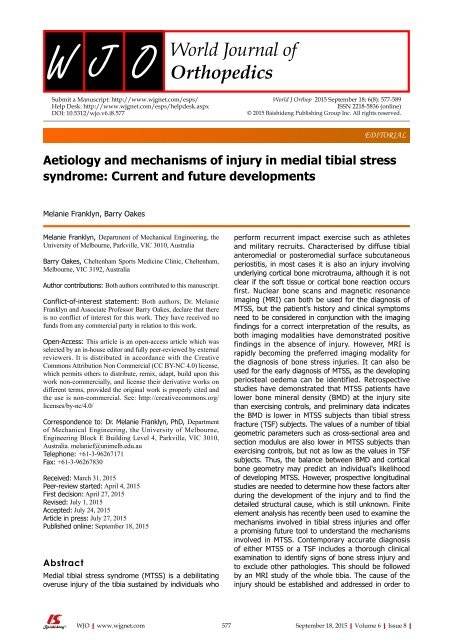You also want an ePaper? Increase the reach of your titles
YUMPU automatically turns print PDFs into web optimized ePapers that Google loves.
Submit a Manuscript: http://www.wjgnet.com/esps/<br />
Help Desk: http://www.wjgnet.com/esps/helpdesk.aspx<br />
DOI: 10.5312/wjo.v6.i8.577<br />
<strong>World</strong> J Orthop 2015 September 18; 6(8): 577-589<br />
ISSN 2218-5836 (online)<br />
© 2015 Baishideng Publishing Group Inc. All rights reserved.<br />
EDITORIAL<br />
Aetiology and mechanisms <strong>of</strong> injury in medial tibial stress<br />
syndrome: Current and future developments<br />
Melanie Franklyn, Barry Oakes<br />
Melanie Franklyn, Department <strong>of</strong> Mechanical Engineering, the<br />
University <strong>of</strong> Melbourne, Parkville, VIC 3010, Australia<br />
Barry Oakes, Cheltenham Sports Medicine Clinic, Cheltenham,<br />
Melbourne, VIC 3192, Australia<br />
Author contributions: Both authors contributed to this manuscript.<br />
Conflict-<strong>of</strong>-interest statement: Both authors, Dr. Melanie<br />
Franklyn and Associate Pr<strong>of</strong>essor Barry Oakes, declare that there<br />
is no conflict <strong>of</strong> interest for this work. They have received no<br />
funds from any commercial party in relation to this work.<br />
Open-Access: This article is an open-access article which was<br />
selected by an in-house editor and fully peer-reviewed by external<br />
reviewers. It is distributed in accordance with the Creative<br />
Commons Attribution Non Commercial (CC BY-NC 4.0) license,<br />
which permits others to distribute, remix, adapt, build upon this<br />
work non-commercially, and license their derivative works on<br />
different terms, provided the original work is properly cited and<br />
the use is non-commercial. See: http://creativecommons.org/<br />
licenses/by-nc/4.0/<br />
Correspondence to: Dr. Melanie Franklyn, PhD, Department<br />
<strong>of</strong> Mechanical Engineering, the University <strong>of</strong> Melbourne,<br />
Engineering Block E Building Level 4, Parkville, VIC 3010,<br />
Australia. melanief@unimelb.edu.au<br />
Telephone: +61-3-96267171<br />
Fax: +61-3-96267830<br />
Received: March 31, 2015<br />
Peer-review started: April 4, 2015<br />
First decision: April 27, 2015<br />
Revised: July 1, 2015<br />
Accepted: July 24, 2015<br />
Article in press: July 27, 2015<br />
Published online: September 18, 2015<br />
Abstract<br />
Medial tibial stress syndrome (MTSS) is a debilitating<br />
overuse injury <strong>of</strong> the tibia sustained by individuals who<br />
perform recurrent impact exercise such as athletes<br />
and military recruits. Characterised by diffuse tibial<br />
anteromedial or posteromedial surface subcutaneous<br />
periostitis, in most cases it is also an injury involving<br />
underlying cortical bone microtrauma, although it is not<br />
clear if the s<strong>of</strong>t tissue or cortical bone reaction occurs<br />
first. Nuclear bone scans and magnetic resonance<br />
imaging (MRI) can both be used for the diagnosis <strong>of</strong><br />
MTSS, but the patient’s history and clinical symptoms<br />
need to be considered in conjunction with the imaging<br />
findings for a correct interpretation <strong>of</strong> the results, as<br />
both imaging modalities have demonstrated positive<br />
findings in the absence <strong>of</strong> injury. However, MRI is<br />
rapidly becoming the preferred imaging modality for<br />
the diagnosis <strong>of</strong> bone stress injuries. It can also be<br />
used for the early diagnosis <strong>of</strong> MTSS, as the developing<br />
periosteal oedema can be identified. Retrospective<br />
studies have demonstrated that MTSS patients have<br />
lower bone mineral density (BMD) at the injury site<br />
than exercising controls, and preliminary data indicates<br />
the BMD is lower in MTSS subjects than tibial stress<br />
fracture (TSF) subjects. The values <strong>of</strong> a number <strong>of</strong> tibial<br />
geometric parameters such as cross-sectional area and<br />
section modulus are also lower in MTSS subjects than<br />
exercising controls, but not as low as the values in TSF<br />
subjects. Thus, the balance between BMD and cortical<br />
bone geometry may predict an individual's likelihood<br />
<strong>of</strong> developing MTSS. However, prospective longitudinal<br />
studies are needed to determine how these factors alter<br />
during the development <strong>of</strong> the injury and to find the<br />
detailed structural cause, which is still unknown. Finite<br />
element analysis has recently been used to examine the<br />
mechanisms involved in tibial stress injuries and <strong>of</strong>fer<br />
a promising future tool to understand the mechanisms<br />
involved in MTSS. Contemporary accurate diagnosis<br />
<strong>of</strong> either MTSS or a TSF includes a thorough clinical<br />
examination to identify signs <strong>of</strong> bone stress injury and<br />
to exclude other pathologies. This should be followed<br />
by an MRI study <strong>of</strong> the whole tibia. The cause <strong>of</strong> the<br />
injury should be established and addressed in order to<br />
WJO|www.wjgnet.com<br />
577 September 18, 2015|Volume 6|Issue 8|


